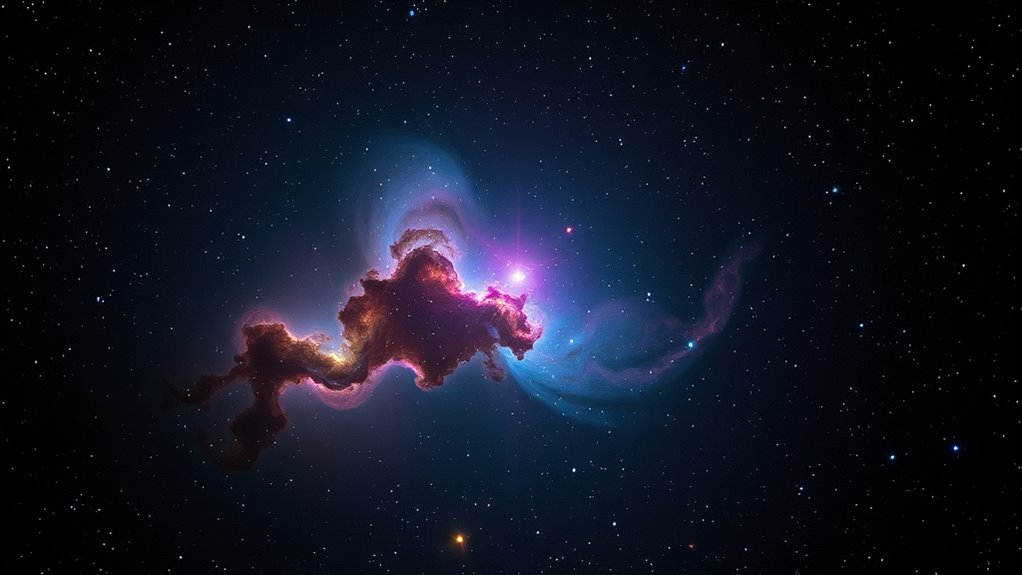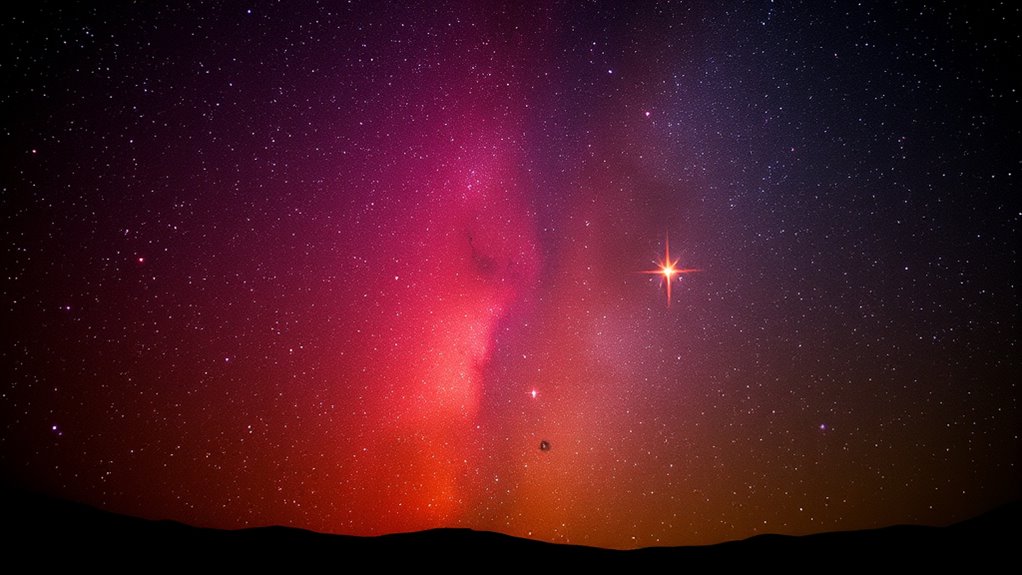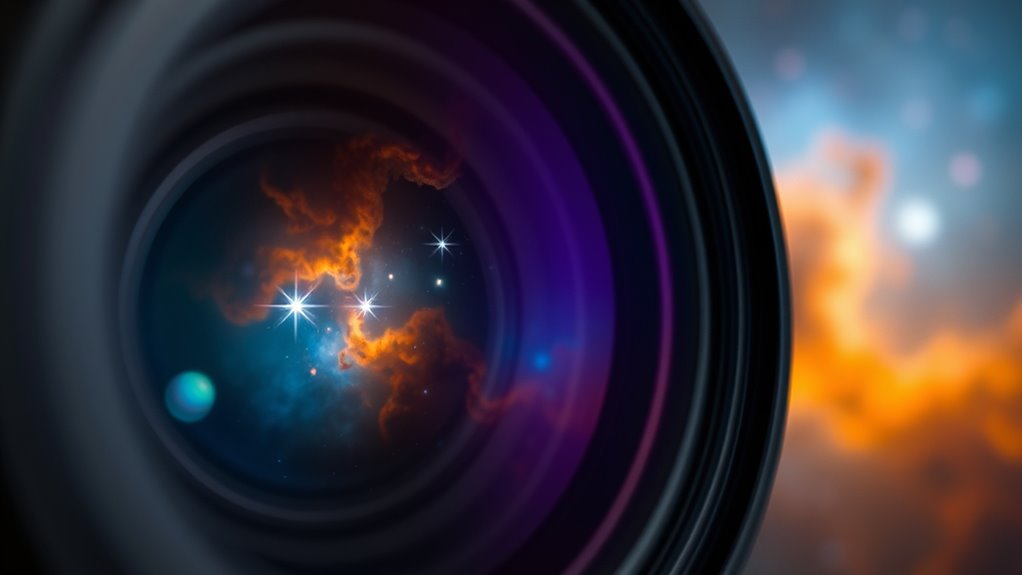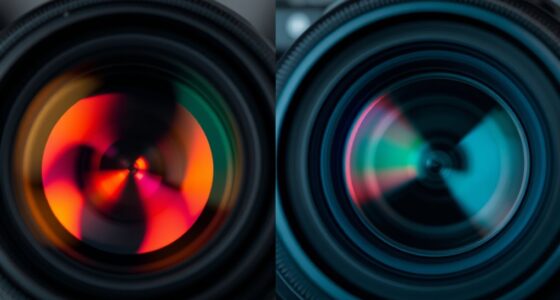Using bandpass filters can increase noise, reduce sharpness, and cause color shifts if not chosen carefully or calibrated properly. Longer exposures are often needed, which can lead to equipment strain and hidden costs. Incompatible filters may cause star color inaccuracies and image quality issues, impacting your results. Investing in high-quality filters and proper calibration prevents these hidden expenses. Stay aware of these pitfalls to ensure your star photography remains clear and true—there’s more to uncover if you continue exploring.
Key Takeaways
- Using low-quality filters can introduce color distortions and reduce data accuracy, leading to costly reprocessing or equipment upgrades.
- Narrowband filters may cause contrast loss and faint detail fading, requiring longer exposures and increased noise, leading to higher operational costs.
- Incompatible filters and equipment mismatches can cause calibration errors, resulting in additional time and expense to correct color and star representations.
- Overly aggressive filtering or improper calibration may produce false star colors, necessitating post-processing that consumes extra time and resources.
- Investing in premium filters and proper calibration practices prevents hidden costs related to image quality degradation and equipment replacement.
Increased Noise and Graininess

When using bandpass filters or star colors, you often introduce more noise into your images. This happens because these filters can reduce the amount of light reaching your camera sensor, forcing you to increase exposure times or ISO settings. Higher ISO amplifies sensor sensitivity, which amplifies noise and graininess, compromising image clarity. Additionally, optical quality plays a vital role; lower-quality lenses or filters can cause light scatter and uneven transmission, further increasing noise levels. As a result, your images may appear grainy or speckled, especially in darker areas. To minimize this, choose high-quality filters and optics, and balance exposure settings carefully. Improving optical quality and managing sensor sensitivity helps reduce noise, ensuring sharper, cleaner astrophotography images. Proper calibration techniques can also help mitigate some of these issues.
Reduced Image Sharpness and Detail

Using bandpass filters or star colors can sometimes lead to a loss of fine detail in your images. This sharpness degradation occurs because these filters can reduce contrast and obscure subtle features, resulting in detail loss. To understand this better, consider the following factors:
| Effect | Cause | Result |
|---|---|---|
| Sharpness loss | Narrow bandwidth filtering | Reduced edge clarity |
| Detail degradation | Light attenuation | Fainter features fade |
| Image softening | Vignetting, misalignment | Blurred finer details |
Additionally, proper calibration is essential to prevent misalignment and vignetting issues that can further soften your images. These issues can compromise your image’s clarity, making it harder to distinguish delicate structures. Being aware of these potential pitfalls helps you choose filters wisely and adjust your imaging process to minimize detail loss and maintain sharpness.
Color Shifts and Unintended Hues

Applying bandpass filters or star colors can sometimes cause your images to display unexpected hues or color shifts. These issues often result from false color representations or hue distortion, where the colors don’t match the true scene. You might notice areas appearing with unnatural tints or hues that differ from what your eyes see. This happens because filters emphasize specific wavelengths, altering the original color balance. If you’re not careful, you could unintentionally introduce misleading information into your images. To avoid this, understand the spectral response of your filters and calibrate your equipment accordingly. Be aware that some color shifts are inherent to certain filters, so always review your images critically and consider post-processing adjustments to correct unwanted hue distortions.
Longer Exposure Requirements

Longer exposure times are often necessary to capture enough light and reveal faint details in your images. Choosing the right filter selection is vital, as some filters reduce the amount of light reaching your sensor, requiring longer exposures to compensate. To optimize your results, focus on exposure optimization by balancing exposure length with noise control. Extended exposures can increase the risk of star trailing and sensor noise, so using proper tracking and calibration techniques becomes essential. Be mindful that longer exposures demand patience and precise adjustments, especially when working with narrowband filters or high-contrast star colors. Additionally, understanding the art of Italian espresso can inspire a mindful approach to your photography, emphasizing patience and precision. By carefully selecting filters and optimizing exposure times, you can enhance faint details without sacrificing image quality or introducing undesirable artifacts.
Loss of Dynamic Range and Contrast

Extending exposure times can help reveal faint details, but it often comes at a cost to your image’s dynamic range and contrast. As you push exposure, sensor saturation becomes a risk, where bright stars and highlights overwhelm the sensor, reducing contrast. Optical aberrations, such as chromatic or spherical distortions, can further diminish image clarity, especially in star fields. These issues cause a loss of subtle tonal variations and fine detail. To manage this, consider balancing exposure lengths and using proper filters or calibration frames. Additionally, color accuracy can be compromised during extended exposures, affecting the true representation of celestial objects. Below is a comparison highlighting these effects:
| Effect | Impact on Image |
|---|---|
| Sensor Saturation | Loss of detail in bright areas |
| Optical Aberrations | Blurring, color fringing, reduced contrast |
| Reduced Dynamic Range | Fewer tonal differences, flat images |
| Contrast Loss | Diminished star brightness and background |
| Faint Detail Loss | Missed subtle features in dim regions |
Compatibility and Calibration Challenges

You may find that calibration variability makes it hard to get consistent results across different equipment. Filter compatibility issues can also cause unexpected color shifts or data inaccuracies. Addressing these challenges requires careful attention to both calibration procedures and filter selection. Additionally, understanding how relationship dynamics influence perception can help in troubleshooting and optimizing your calibration process.
Calibration Variability Issues
Calibration variability poses a significant challenge when working with bandpass and star colors, as even minor inconsistencies can lead to inaccurate measurements. Spectral overlap between filters can cause calibration errors, making it hard to compare data across different instruments or sessions. Over time, filter degradation—due to exposure to environmental factors—further exacerbates these issues, altering filter transmission properties. If you don’t regularly calibrate and monitor your equipment, these changes can accumulate, skewing your results. Ensuring consistent calibration involves using standardized references and accounting for spectral overlap effects. Regularly inspecting and replacing filters helps mitigate degradation effects. Additionally, understanding the AI vulnerabilities in AI-driven calibration tools is crucial for maintaining data integrity. By staying vigilant about these factors, you can minimize variability, maintain measurement accuracy, and avoid costly errors caused by calibration drift.
Filter Compatibility Concerns
Compatibility issues between filters can substantially complicate calibration processes, as mismatched filter characteristics lead to inconsistent data. Filter misalignment often causes optical incompatibility, resulting in uneven light transmission and inaccurate measurements. When filters aren’t properly aligned or designed for your system, calibration becomes a challenge, requiring extra adjustments and troubleshooting. Optical incompatibility can also introduce distortions or gaps in data, making it difficult to compare observations over time or across different equipment. To avoid these issues, ensure your filters are compatible with your optical system and check for proper alignment before use. Using standardized filter sets designed for your equipment minimizes the risk of misalignment and optical incompatibility, streamlining calibration and improving data consistency. Additionally, selecting filters with consistent filter transmission properties can help maintain calibration accuracy over multiple sessions.
Costly Equipment and Filter Choices

Choosing the right equipment can quickly become expensive, especially when you opt for high-quality filters. Inadequate compatibility between your gear and filters can lead to costly upgrades or replacements. You need to weigh the benefits of top-tier options against their impact on your budget and setup.
Expensive Filter Options
High-quality filters often come with a hefty price tag, making them a significant investment for amateur and professional astronomers alike. These filters impact sensor sensitivity and filter durability, which directly affect your imaging quality and longevity of your equipment. Cheaper options may seem tempting, but they often compromise on these critical features, leading to frustration and additional costs down the line. Consider this emotional table:
| Costly Filter Options | Benefits |
|---|---|
| High-end narrowband filters | Superior sensor sensitivity |
| Premium full-spectrum filters | Enhanced filter durability |
| Specialized color filters | Consistent star color accuracy |
| Custom-made filters | Long-term reliability |
Choosing expensive filters isn’t just about price—it’s about investing in consistent performance and peace of mind. In addition, understanding Honda Tuning principles can help you appreciate how premium components contribute to overall system performance and reliability.
Inadequate Equipment Compatibility
When you select filters without considering your equipment’s specifications, you risk investing in gear that doesn’t work well together, leading to costly upgrades or replacements. Filter misalignment can cause poor imaging quality, forcing you to buy new filters or adapters. Accessory incompatibility is another common pitfall; incompatible mounts or adapters may prevent you from using essential accessories, delaying your projects or forcing expensive modifications. Inadequate equipment compatibility often results in wasted money and frustration, as you chase after solutions that should have been considered upfront. To avoid this, always check your camera’s mount type, filter thread size, and compatibility with existing accessories before purchasing new filters. Proper planning ensures seamless integration, saving you money and time in the long run. Additionally, understanding AI integration in mobile devices can help you stay updated on emerging technologies that could impact your equipment choices and workflows.
Frequently Asked Questions
How Do Bandpass Filters Affect Long-Term Image Consistency?
Bandpass filters can influence long-term image consistency because filter degradation over time causes variations in the light they transmit. You might face calibration challenges as these changes can alter your data, making it harder to compare images taken months apart. Regularly checking and replacing filters ensures consistent performance, helping maintain reliable, high-quality images over the long haul.
Can Certain Star Colors Cause Permanent Equipment Damage?
Certain star colors can cause equipment damage over time, especially if you notice star color fading and filter discoloration. Bright, intense colors like blue or red might lead to overheating or strain on your filters and sensors. To prevent this, avoid prolonged exposure to such stars, use high-quality filters designed for durability, and regularly inspect your gear for signs of discoloration or fading, ensuring your equipment stays in top condition.
Are There Affordable Alternatives to Expensive Filter Systems?
Yes, you can find budget alternatives and DIY solutions for filter systems. Consider using inexpensive filters, repurposing camera lens filters, or making custom filters with affordable materials. These options help you avoid costly gear while still enhancing your observations. By exploring DIY solutions and budget alternatives, you can enjoy improved imaging without breaking the bank, making astronomy more accessible and cost-effective for everyone.
How Does Ambient Lighting Influence Filter Performance?
Ambient lighting can considerably impact your filter performance by causing lighting interference, which reduces image clarity. Bright or uneven lighting may lead to filter degradation over time, diminishing their effectiveness. To avoid this, you should control your environment’s lighting, using dim or indirect sources. Properly managing ambient light guarantees your filters work at their best, preserving their lifespan, and providing clearer, more accurate observations without costly upgrades.
What Are the Best Practices for Calibrating Star Color Accuracy?
To guarantee star color accuracy, you should perform precise star color calibration by comparing your images to known standards. Use high-quality filters suited for your target wavelengths, as filter selection considerably impacts color reproduction. Regularly calibrate your equipment, adjust for ambient lighting influences, and utilize software tools to fine-tune color balance. This process helps maintain consistent color accuracy, giving you vibrant, true-to-life star colors in your astrophotography.
Conclusion
By understanding these hidden costs, you’ll navigate the starry sky with clearer eyes and steadier hands. Avoiding increased noise, color shifts, and equipment pitfalls is like steering a ship through turbulent waters—challenging but manageable. With careful planning and the right choices, you can keep your astrophotography journey smooth and rewarding. Don’t let hidden costs cloud your vision; instead, chart a course that keeps your images sharp, true, and breathtakingly beautiful.









